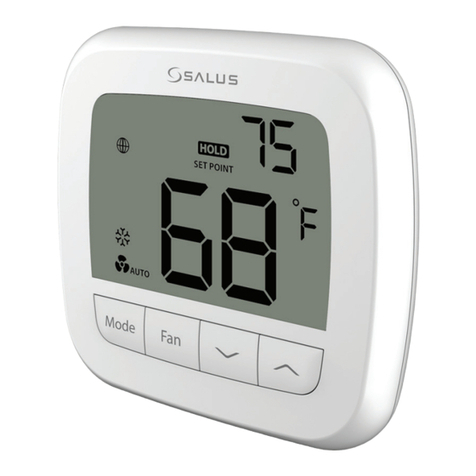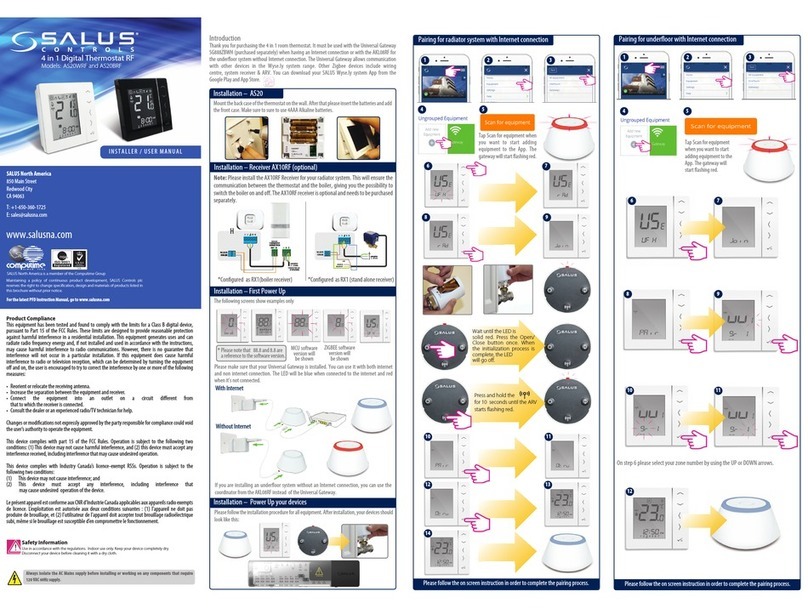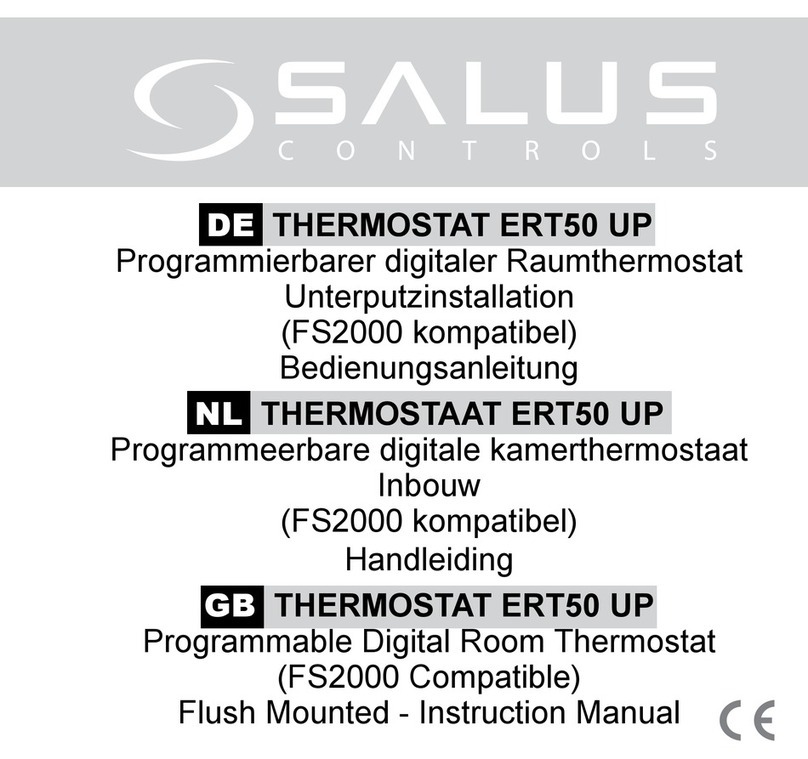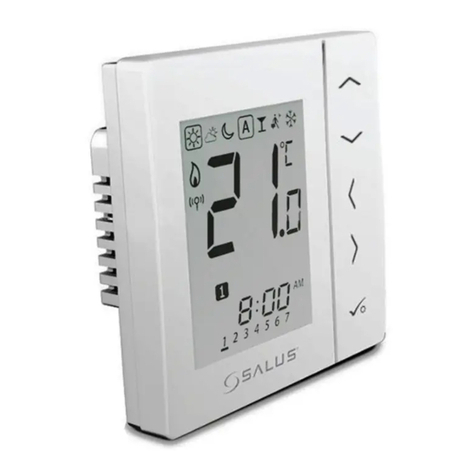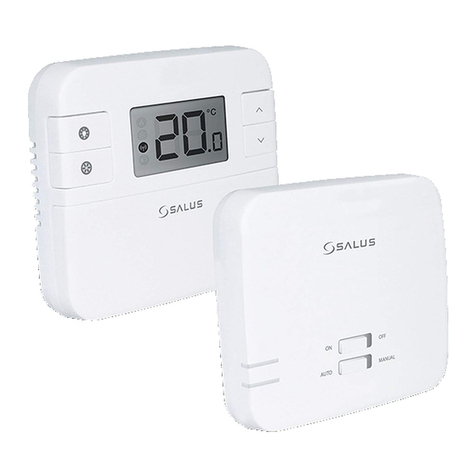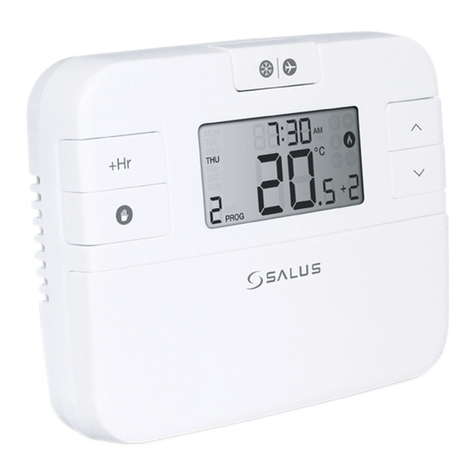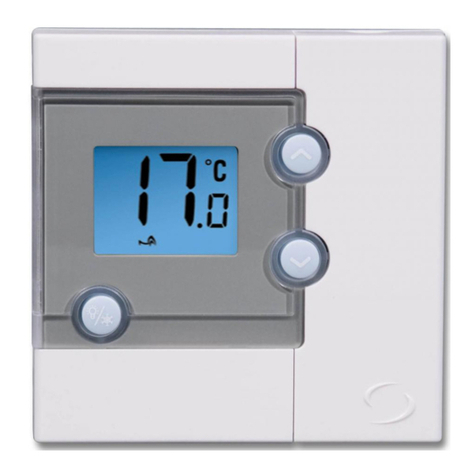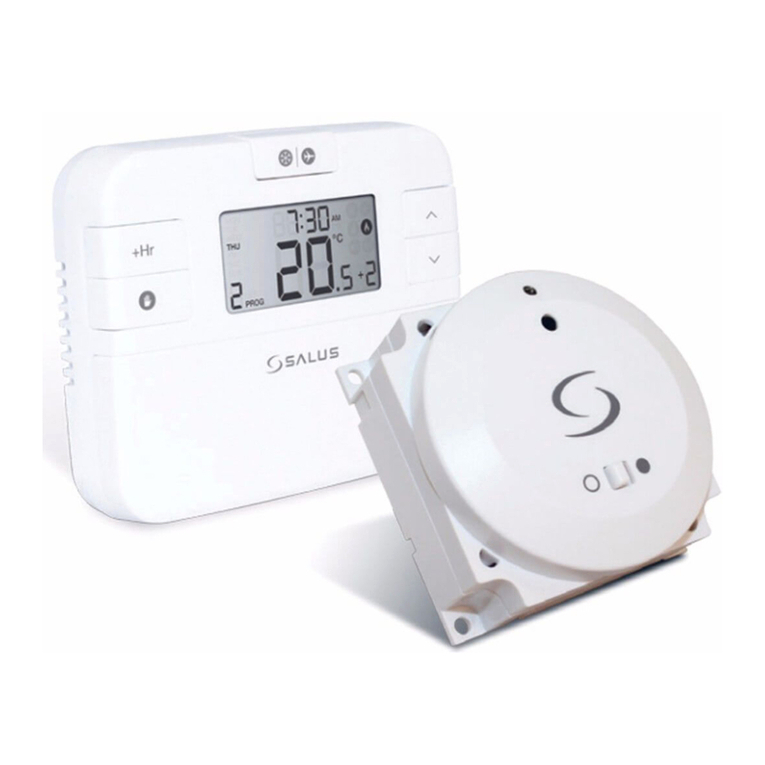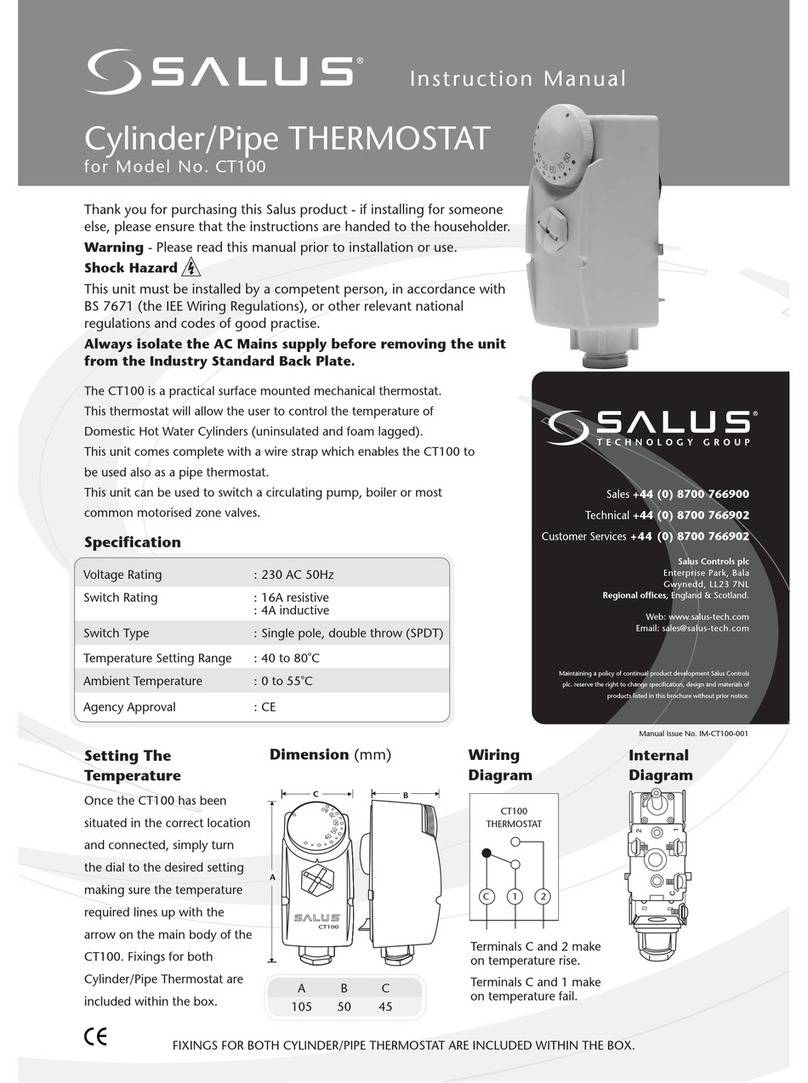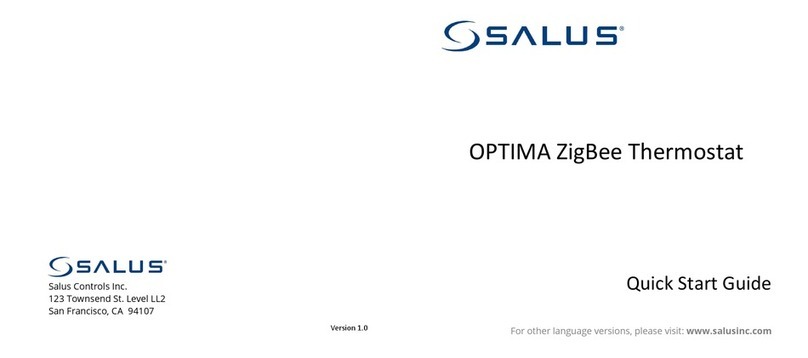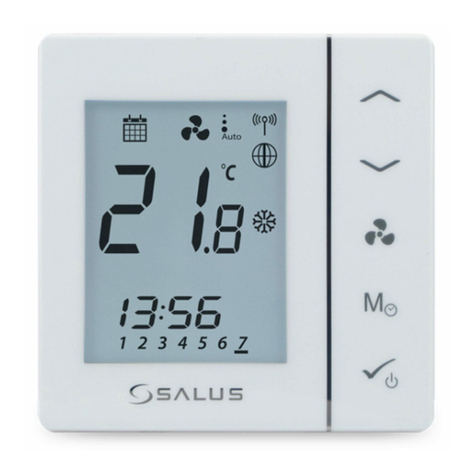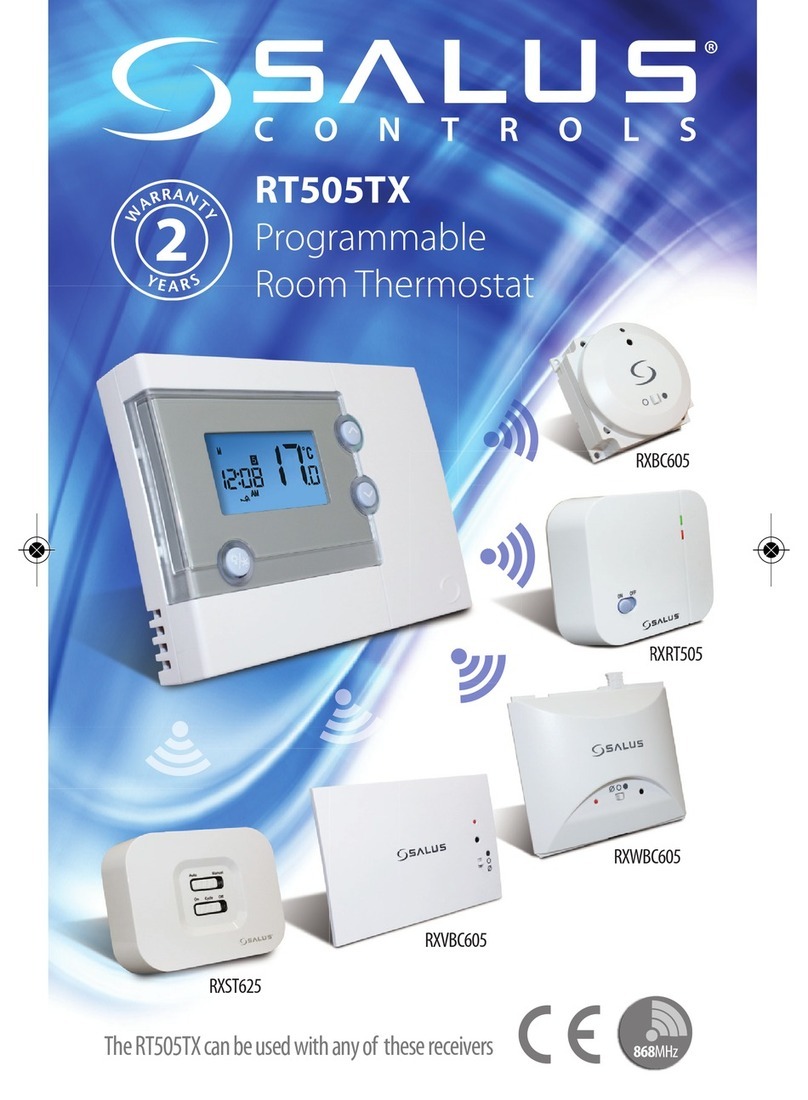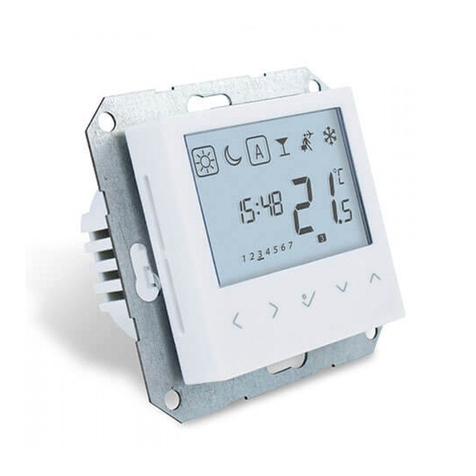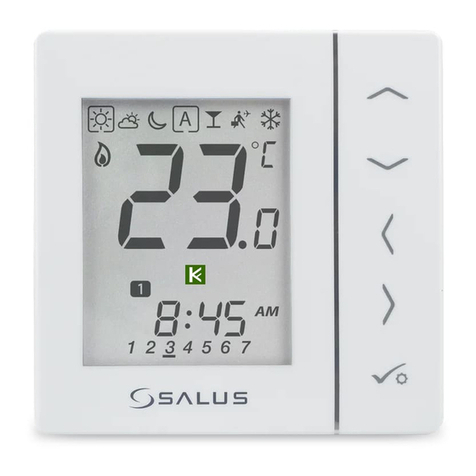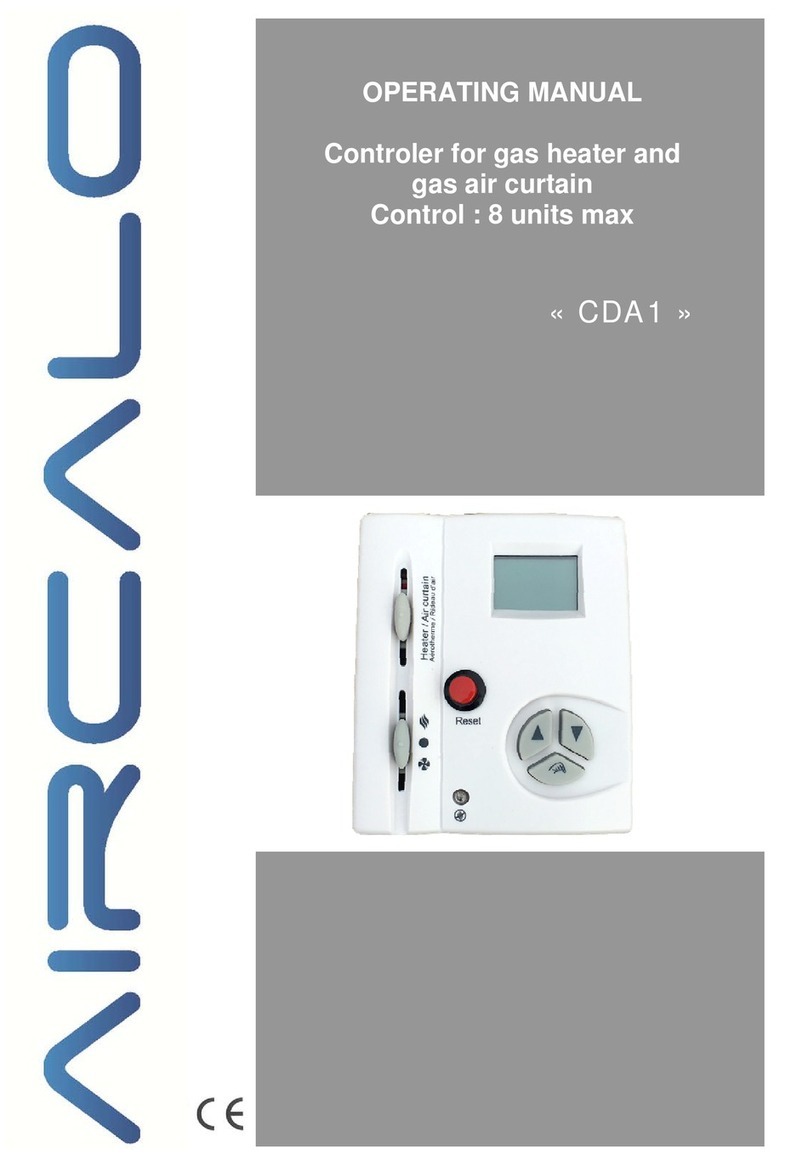1) Remember to Isolate AC mains supply, note this
must be 230V AC and fused at 13 amps max.
2) Select a suitable indoor location free from water and
moisture.
3) The receiver should not be shielded from the RF signal in
any way, follow ‘Testing the RF Transmission’ section of
this manual before deciding on a final location for the
receiver and control centre units.
4) To access the wiring terminals carefully prize off the front
cover from the top middle of the receiver with a flat head
screw driver and remove the 2 screws underneath as
illustrated in the diagram.
Salus Controls plc
Enterprise Park, Bala
Gwyne dd, LL23 7NL
Regional offices, England & Scotland.
Web: www.salus-tech.com
Email: sales@sa lu s-tech .co m
Sales +44 (0) 87 00 766900
Technical +44 (0) 87 00 766902
Maintaining a policy of continual product
development Salus Controls plc. reserve the right to
change specification, design and materials of
products listed in this brochure without prior notice.
Manual Issue No. IM-RT500RF-002
Programmable
THERMOSTAT
In stru ct io n Ma nu al
for Model No. RT500RF
PRIOR TO INSTALLING PLEASE READ THE
INSTALLATION GUIDE
INTRODUCTION
This thermostat can replace most common residential
thermostats and is designed to be used with electric, gas or
oil heating control systems.
Unlike ordinary single unit design thermostats, this is a new
type of thermostat separating the operational functions into
two units. The Receiver serves for wiring connections and
heat on/off control. The Control Centre serves as user
interface and temperature sensing/control. The two units are
linked by Radio Frequency.
The RT500RF is easily installed using the Industry Standard
back plate supplied (for mounting purposes only as no
wiring is required when installing the control centre).
The back plate can be mounted directly to the wall surface.
1 2 3 4 5 6 8 9 10 11 12 13 14 15 16 17 18
The reset button must be pressed after changing jumper positions
Following table is the setting of the
thermostat after reset or Power on:
After reset or power on, the thermostat will operate in
Normal mode. Setpoint temperature is reset to default
setting. Room temperature is updated in 5 seconds and
the control process starts. Program Number is updated
to indicate the running program.
Function
Status after Reset or Power on
Operation Mode Normal mode
Room Temperature 22.0°C, to be renewed
within 5 seconds
°C indicator On
Clock 12:00
AM/PM indicator AM
Day of Week indicator M
Program Default factory setting
Setpoint Temperature Default factory setting
Program Number 1
indicator
SET indicator Off
PROG indicator Off
Frost Protection Off
indicator
Heat indicator Off
Low-Battery Warning Off, to be renewed
indicator within 5 seconds
Output Relay Off
Initial Power Up or Reset
• After power up or RESET is pressed, the
thermostat is reset.
•
During system reset, all LCD segments are turned on
for 2 seconds after which the Control Centre is
initialized.
• Once initialized the following display is shown.
• The default Program
Set-point
temperatures are set
after reset. Same for
both 5-2 and 7 days
program.
User Guide
Key Function
Increase Setpoint Temperature
Decrease Setpoint Temperature
BL/FROST Turn on backlight for 5 seconds,
activate/de-activate Frost Protection
SET Key for Clock/Program settings
SELECT Key for Clock/Program settings
RESET System reset
•The setting range is 10°C - 35°C in steps of
0.5°C.
• Setpoint Temperature will stop flashing when a
key is pressed, then flashes again once the key is
released.
•Press SET at any time to confirm the setting
and return to normal mode.
• Thermostat will return to normal mode after 3-4
seconds if no key is pressed.
Temporary override remains active until clock or
program setting are adjusted, Frost protection is
activated or the next program time / temperature
set-point is reached.
Low-Battery Detection:
Sleep Mode:
•Press and hold and in Normal mode for 3
seconds simultaneously to enter the Sleep mode.
•All the functions will be paused to save battery power.
• The whole LCD will be blank.
• Output will be turned off immediately.
•Press any key to wake up the unit.
•Clock is continuously running in background.
•Press SET at any time during program set and
selection will immediately return to Normal mode.
•Press SELECT at any time to confirm the selection.
"Hour" is flashing
to indicate that
it is the selected
item to be
adjusted.
7 days program selected
• 5 different sets of Time and Setpoint
temperature can be set for each Day of Week.
Total 35 settings.
• To review or change program, press SET in
Normal mode to enter Program Setting mode.
Program 1 of Monday, and "SET PROG" are
displayed. All other indicators are cleared. "Day
of Week" is flashing to indicate that it is the
selected item to be adjusted.
•Press or to
select the
program set for
Day of Week to
be reviewed or
adjusted.
•Press “Set” to confirm at anytime to return.
Frost Protection:
•Press and hold BL/FROST in Normal mode for 3
seconds to activate the Frost Protection.
The Setpoint temperature is automatically set to 5°C
to prevent frosting.
Temporary Override:
•Press or when reviewing Setpoint
Temperature to enter Manual Override mode,
the Setpoint Temperature is increased or
decreased by 0.5°C accordingly.
•In Normal mode, press and hold or to
display the Setpoint temperature. After 2
seconds, the Thermostat will enter Manual
Override mode and start fast advance in 4Hz. If
buttons are released within 2 seconds without
entering Manual Override mode, this is treated
as reviewing Setpoint Temperature only.
• Release and press or again to increase or
decrease the manual override Setpoint
temperature by 0.5°C respectively.
• Hold or for another 2 seconds to enter fast
advance in 4Hz.
Reviewing Setpoint Temperature:
•Press or to review the Setpoint
temperature.
When any program is running, the LCD will show
the program Setpoint temperature with the "SET"
indicator displayed.
When operating in Frost protection mode, the LCD
will show 5°C with the Frost Protection indicator
displayed.
When operating in Temporary Override mode, the
LCD will show the temporary Setpoint temperature
7
•Press any key except or, or wait 3-4
seconds without key press to return to normal
mode, room temperature will be displayed.
Thank you for purchasing this Salus product
- if installing for someone else, please ensure that
the instructions are handed to the householder.
Warning - Please read this manual prior to
installation or use.
Shock Hazard
This unit must be installed by a competent person,
in accordance with BS 7671 (the IEE Wiring
Regulations), or other relevant national regulations
and codes of good practice.
Always isolate the AC Mains supply before
installing this unit.
Jumpers Function
Span 1 moveable Jumper for selecting
temperature span of +/-0.5°C
(factory default setting) or 1.0°C
Program 1 Jumper for 5-2 (factory default setting)
or 7 day programming.
1,2,3,4,5 5 removable Jumpers for altering the
RF address code when used in
conjunction with the receivers
corresponding dip switch.
Switches/Jumpers:
The installer should select the jumper positions required if
changing from the factory presets. These jumpers are found
on the rear of the unit.
WIRING DIAGRAM
FOR 230V APPLICATION
The unit is default 230V, if volt free application is
required you must remove link & follow wiring
diagram for volt free appication.
WIRING DIAGRAM
FOR VOLT FREE APPLICATION
The unit still requires a 230V feed for V.F. applications
L - Live (230V Feed)
N - Neutral
NC - Normally Closed*
COM - Volt Free Feed
NO - Switched Live (Volt Free)
(Remove Link!!!)
SL (Off) - Heat Off*
L - Live
SL (On) - Heat On
N - Neutral
It is vital to connect the live
into this terminal to avoid
overloading of the jump
wire.
Program Setting Mode:
5-2 days program selected
• 5 different sets of Time and Setpoint temperature can
be set for Weekday or Weekend.
• To review or change program, press SET in Normal
mode to enter Program Setting mode. Program 1 of
the Weekday, and "SET PROG" are displayed. All other
indicators are cleared. "Weekday" is flashing to indicate
that it is the selected item to be adjusted.
• Release SET and SELECT, press or to increase
or decrease the "hour" respectively.
• Press and release SELECT, press or to
increase or decrease the "minute" respectively.
• Press and release SELECT, press or to cycle
the Day of Week from "M" to "SU".
• Press and release SELECT to allow change of
"hour" again.
• Press and hold or for 2 seconds to enter fast
advance in 4Hz.
• Selected item will stop flashing when a key is
pressed. The selected item will flash again once
the key is released.
• Press SET at any time to confirm the setting and
return to normal mode.
• The Control Centre will return to normal mode after
15 seconds if no keys are pressed, Clock is also
updated with the latest setting. •Press SELECT to select the items to be
reviewed or adjusted with the below sequences.
(Program 1) "hour" "minute" Setpoint temp
(Program 2) "hour" "minute" Setpoint temp
(Program 3) "hour" "minute" Setpoint temp
(Program 4) "hour" "minute" Setpoint temp
(Program 5) "hour" "minute" Setpoint temp
and then cycle backto (Program 1)
•Press SET at any time to confirm the setting
and return for program set selection.
•Press or to
select the program
set for Weekday /
Weekend to be
reviewed or adjusted.
Press SELECT at any time to confirm the selection.
"Hour" is flashing to indicate that it is the selected item
to be adjusted.
Press SELECT at any
time to confirm the
selection. "Hour" is
flashing to indicate that
it is the selected item to
be adjusted.
•Press SET at any time during program set, this will
immediately return to Normal mode.
RF Address Code Setting
If there is another user nearby, e.g. in the next house, your
receiver may be fault triggered by their transmitter. You may
select a different RF address code to prevent this. The
receiver can only respond to RF transmissions with the same
address code setting as its own address code.
Address Code Dip
Switch Leavers.
1. To adjust address code of Receiver, simply
push up one or more of the 5 dip switch levers.
The leavers are numbered 1 to 5 from left to right.
2. To adjust address code of Control Centre, remove
one or more of the jumper caps located on the
back of the unit, labeled 1,2,3,4,5.
3. You must press reset on the control centre after
altering the address code.
Caution :
1. Address code of Control Centre must be the
same as address code of Receiver. For any
jumper cap removal of address code # in
Control Centre, the same address code # of
Receiver must be put to the UP position.
2. Disconnect AC power and
remove batteries
prior to adjusting
address code.
Specification
Switch Rating : Volt free selectable
230V AC 16 (8)A max
Power Supply : 2 x AA size Alkaline batteries
Operating Temperature : 0˚C - 50˚C
Temperature Setting Range : 5˚C - 35˚C in 0.5˚C steps
Storage Conditions : -20˚C - 55˚C to 90% RH/non
condensing
Frost Protection Temperature : 5˚C
Battery Low Warning : 2.6 - 2.8V
Temperature Control Accuracy : +/- 0.5˚C at 25˚C
Operating Humidity : 0 to 90% RH/non condensing
Time Display : 12 hour/24 hour
Clock Accuracy : +/- 1 min/month
Protection : Auto cut off at over 35˚C
Memory : Memory hold up: 5 minutes
Back Light : EL Panel blue colour
Agency Approval : CE
Micro disconnection on operation : Type 1.B control action
Rated Impulse Voltage : 4kV
Front cover
LED
Indicators
Power
switch
Front inside view
ON
OFF
Receiver On/Off switch and LED’s
On removing the front cover you will note there is an On/Off
switch and 2 LED’s. The switch allows you to turn off the
Receiver if necessary to prevent it calling for heat. The left LED
illuminates red when the switch is in On position and the unit
is receiving power. The other LED illuminates green when the
receiver unit is calling for heat upon receiving a heat call
transmission from the Control Centre.
TESTING THE RF TRANSMISSION
It is important to site the Receiver and Control Centre in
locations where the RF signal cannot be interrupted. The
receiving range between Control Centre and Receiver is
60M in open area. Many factors can affect the RF
transmission, shortening the operating distance e.g.
shielding by thick walls, foil back plasterboard, metal
objects such as filing cabinets, general RF interference
etc, However, the range is enough for most household
applications.
It is advisable to test the RF transmission from the
intended Control Centre location to the Receiver location
before fixing the Control Centre to the wall.
1. Press UP button until the set-point temperature is higher
than room temperature by a few degrees.
2. Wait for a few seconds. The animated flame (heat call
indicator) should appear on the bottom left of the LCD on
the control centre.
3. Check the green LED on the receiver unit. It should be
illuminated.
4. Press Down button to adjust the set-point temperature to
be lower than room temperature. Wait for a few seconds.
The animated flame (heat call indicator) should disappear
and the green LED should switch off
5. If at step 3 the LED is not illuminated, press RESET and try
to place the Control Centre closer to the Receiver,
repeating steps 1 to 4.
6. Alternatively you can try and alter the address code
following the ‘RF Address Code Setting’ section of this
manual, then repeat steps 1 to 4.
Note that the RESET button on the Control Centre should be
pressed after altering the address code.
LCD Backlight:
• LCD backlight is activated when BL/FROST or
any key is pressed. The backlight will
automatically turn off in 5 seconds after all keys
are released.
• LCD backlight will not operate when battery is low.
• LCD backlight is illuminated throughout the
Clock, Program, and Temporary Override
Temperature settings.
Battery voltageis sampled
every minute. When the
battery voltage drops to a
certain level, the Low-Battery
warning indicator appears.
• The control centre functions normally during battery
low. However, user must change the batteries as soon
as possiblebefore they are so weak that normal
operation cannot be assured.
•Battery voltageis determined as "low" when it is less
than or equal to 2.6V. It is determined as normal
when it is higher than or equal to 2.8V, i.e. Low-
Battery indicator must come out when battery voltage
is <= 2.6V, and must be turned off when battery
voltage is >= 2.8V.
•Battery voltageis only sampled in Normal mode
and when LCD backlight is turned off.
Wiring the Receiver for the RT500RF
This product requires 2 x AA size Alkaline batteries.
Multiple Thermostat Installations
Please note, if using more than one RT500RF in the same
installation, be sure that there is at least a 1 metre gap
between receiver units to avoid RF interference.
When installing multiple thermostats you should ensure that you assign
different address codes for each RT500RF following the ‘RF Address Code
Setting’ section of this manual. Each RT500RF should be introduced to
the installation one at a time with all other receiver units switched off, also
make sure that the batteries are removed from all other Control Centres.
Install each unit following the ‘TESTING THE RF TRANSMISSION’ section
of this manual. Once you are happy with the operation of one unit you
may install the next. Once all RT500RFs are installed, if one unit then
seems to function abnormally, try changing the address code of the
control centre & its corresponding receiver again taking care that the new
code given is different to all others in the installation.
The control centre sends RF On/Off signals every 10 min to ensure the
receiver is in the correct state. If for some reason the 1st RF signal is
interrupted you may notice the control centre has started/stopped calling
for heat but the receiver hasn’t switched. Simply wait 10 minutes until the
next RF signal is transmitted and the receiver unit should switch.
* Not Normally Used
• Clock, Day-of-Week, and "SET" are displayed.
All other indicators are cleared.
The Setpoint temperature is flashing to indicate that
it can be changed now.
Press BL/FROST for 3 seconds to de-activate the
Frost Protection, the Frost Protection indicator is
turned off.
Whenever the Frost
Protection is activated, the
Frost Protection indicator
is animated with the
below sequence in 4Hz.
WIRING INTO THE EXTERNAL THERMOSTAT
LOOP OF A BOILER
(Remove Link on Receiver &
External Thermostat Link on Boiler!!!)
The unit still requires a 230V Permanent Live feed
L Live (230V Permanent Feed)
N Neutral
NC Normally Closed {Not Used}
COM Live Feed from boiler
external thermostat loop
NO Switched Live feed back to
other side of boiler external
thermostat loop
